Canadian hydropower has contributed to America’s clean energy economy, and has the potential to provide our nation with more clean energy. The question is, how can Canada and the United States strengthen this trade relationship?
An event last week called Power Partnerships: How Canada-U.S. Hydroelectric Partnerships Reinforce America’s Clean Energy Economy, held at the Wilson Center in Washington D.C., brought together representatives from public utilities, think tanks, and government officials to answer that question.
Canadian hydropower has been supplying baseload power to the U.S. electric grid for more than 40 years. In 2010, the U.S. imported 43.8 terawatt-hours of electricity from Canada, of which about 80 percent was from hydropower. Though Canadian electricity imports make up just 1 percent of total U.S. annual electricity generation, hydropower imports make up about 10 percent of all U.S. renewable electricity consumption.
The event speakers discussed the barriers that currently prevent Canadian hydropower imports from becoming an even bigger part of the U.S. energy mix, including transmission capacity, low natural gas prices, the potential threat to domestic jobs, competition from other renewables, environmental concerns, and regulatory barriers. Overcoming some of these challenges won’t be easy, but the case for moving forward is clear: benefits include greater energy security, affordable power prices, and reliable baseload power which can help to integrate intermittent renewable energy sources.
The event panelists included Canadian Ambassador to the United States Gary Doer, Premier of Manitoba Greg Selinger, Commissioner of the Federal Energy Regulatory Commission Tony Clark, Minnesota Power Executive Vice President David McMillan, Hydro-Quebec-US Vice President Stephen Molodetz, and Richard Caperton, Director for Clean Energy Investment at the Center for American Progress -- all of who discussed their take on the benefits of imported hydropower from Canada, and offered ways to facilitate greater cross-border clean energy trade.
On building new hydropower projects and transmission lines, Molodetz put forward an option for more positive and productive stakeholder involvement. He said there is a need for a “regional venue” to talk about the benefits of any new projects, since there tends to be so much focus on transmission siting and the negative aspects of that. He also cautioned against an “either/or” mentality, noting that hydro imports are part of a clean energy strategy and shouldn’t be seen as something that would necessarily crowd out other renewables.
Another important point that was mentioned several times was the fact that most states’ renewable energy portfolio standards (RPSs) do not include imported hydropower as an eligible resource. This is partly because it would allow some states with plentiful hydropower resources to easily meet their RPS target, rather than encouraging the development of other renewable energy sources. However, there are opportunities for states to encourage the growth of all renewables, including imported hydropower.
Caperton stated that if Canadian hydro imports were counted in states’ RPSs, the renewable targets must be increased in order to displace dirty energy sources rather than wind or solar. These increased targets would put the U.S. on a path to utilize more clean energy and further reduce greenhouse gas emissions.
Although the Keystone XL decision has the potential to define President Obama’s climate legacy, there are cleaner energy sources that the U.S. could import from its northern neighbors that could lead to a lower carbon future. If we can adequately address the current barriers to importing more hydro and ensure that it is displacing coal, Canadian hydropower could become an even greater part of the United States' clean energy economy and strengthen the relationship between the two nations.
***
Mari Hernandez is a Research Associate in Energy Policy for the Center for American Progress.



